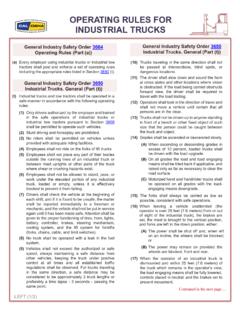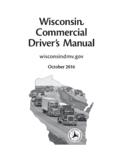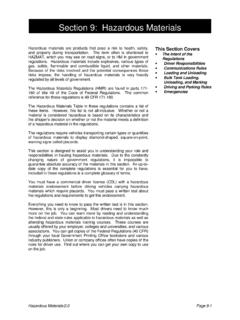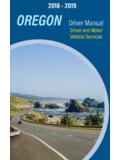Transcription of Risk Assessment Part A – Generic Hazards
1 KMA Ltd. Issue 1/11. August 2011. Completion of this document converts it into a site specific Assessment . To be reviewed in August 2012. Page 1 of 5 Risk Assessment Part A Generic Hazards Activity: Deliveries to Sites Client: Site: Date of Assessment : Hazards Harm Risk prior to Control Measures Persons at Risk Required Control Measures Records/Actions Risk - Control Measures Applied Collision with persons, structures Legal competence of driver Mechanical breakdown Carriage, loading/ unloading of vehicles Carriage of dangerous materials Tipping of vehicle Injuries. Collapsing structures Invalid insurance Accident leading to injury Back and MSD injuries COSHH, injuries Injuries S=5 L=2 R=Medium S=2 L=2 R=Medium S=4 L=2 R=Medium S=4 L=2 R=Medium S=4 L=2 R=Medium S=4 L=2 R=Medium All site personnel Company All site personnel Operatives Operatives Operatives drivers must be competent, Second man may be required to assist with reversing and manoeuvring of vehicles in tight/awkward locations.
2 New/inexperienced drivers are under supervision from experienced employees when driving commercial vehicles. Only drivers over 21 years of age are allowed to drive commercial vehicles. Employees driving licences are checked on a yearly basis. Servicing is undertaken on all vehicles in line with the manufacturer s recommendations. Daily check of tyres, lights, brakes etc All operatives undertake manual handling training at regular intervals. Second man available to assist with the loading and unloading of vehicles if Assessment shows requirement. Vehicles are specifically designed to carry loads that are used for. Any dangerous substance/ material will be identified and the relevant signage supplied. Substance/ material to be adequately secured to prevent movement. Care will be taken when loading up so to avoid the possibility of the vehicle over turning.
3 Care to be taken when parking. Planning, employment checks Personnel Records Safety Check sheets, maintenance records Training, supervision Planning, training, supervision Planning, training, supervision S=5 L=1 R=Low S=2 L=1 R= Low S=4 L=1 R= Low S=4 L=1 R= Low S=4 L=1 R= Low S=4 L=1 R= Low KMA Ltd. Issue 1/11. August 2011. Completion of this document converts it into a site specific Assessment . To be reviewed in August 2012. Page 2 of 5 Hazards Harm Risk prior to Control Measures Persons at Risk Required Control Measures Records/Actions Risk - Control Measures Applied Failure in operation Incorrect Operation other vehicles/ adjacent objects other vehicles colliding with semi-lowered platform Slips, trips and falls when loading/ unloading via platform Manual Handling Crushing and entrapment injuries Crushing and entrapment injuries Collisions, physical damage Collisions.
4 Physical damage Fall injuries Musculoskeletal disorders S=4 L=2 R= Medium S=4 L=2 R= Medium S=3 L=2 R= Medium S=4 L=2 R= Medium S=5 L=2 R= High S=3 L=2 R= Medium Operatives Operative Public other road users Operatives Operatives Tail Lift Use Machinery to be regularly maintained and checked Operators to be trained in operation of controls and Hazards Driver to ensure adequate clearance when positioning vehicle (width of platform plus operating area as minimum) Vertical indicators visible from rear, well-lit locations, rear lights to be on in poor conditions Operatives to be aware of obstructions on and by platform, including gap between rear of platform and deck. Beware of step up when platform lowered. Well-lit area required during operations.
5 Load movements to be planned to minimise clutter and maximise space on platform Operatives to be trained in manual handling, mechanical aids to be utilised wherever possible. When load assessed as more than one-man lift assistance to be sought Servicing history Training records Training and supervision Training and supervision Training and supervision Training, training records S=4 L=1 R=Low S=4 L=1 R= Low S=3 L=1 R= Low S=4 L=1 R= Low S=5 L=1 R= Low S=3 L=1 R= Low KMA Ltd. Issue 1/11. August 2011. Completion of this document converts it into a site specific Assessment . To be reviewed in August 2012. Page 3 of 5 Hazards Harm Risk prior to Control Measures Persons at Risk Required Control Measures Records/Actions Risk - Control Measures Applied Failure in operation Incorrect Operation Incorrect positioning of vehicle Unstable vehicle Fall from back of lorry/load when connecting/ removing hook Crushing and entrapment injuries Crushing and entrapment injuries Trapping of operator/ other persons Damage to load or other items Toppling of lorry/ load Fall injuries S=3 L=2 R= Medium S=3 L=2 R= Medium S=3 L=2 R= Medium S=4 L=2 R= Medium S=5 L=2 R= High Operatives Operative Operative/ adjacent persons Operative/ adjacent persons Operatives Use of Lorry Mounted Cranes Hiab Machinery to be regularly maintained and
6 Checked Operators to be trained in operation of controls and Hazards Operator should be positioned on the opposite side of the truck to that which the load will be lifted or lowered. Operator should have a clear view of the area where the load will be lifted from or lowered onto. Ensure that loads will not become snagged which may cause equipment failure. This may require an observer or guide ropes to be attached. Stabilisers MUST be lowered and on firm footing. NOTE: The truck wheel should not be lifted off the ground as they supply the main stability. Ensure: Parking brake is applied. That the truck wheels are chocked if the ground slopes. Weight within SWL It is recommended that the ground should not slope more than 5 degrees Wherever possible work is to be carried out at ground level.
7 Where this is not possible care is to be taken at all times when working on the back of the lorry. Where load will require operative to stand in an insecure place ( a requirement to climb load to connect/disconnect slings) operative to wear harness and connect fall arrest block. Hook to be raised above load slinging position. Fall arrest block to be connected to hook before slings. Load to be lifted into position on lorry and operative to climb to the safest position to enable the slings to be unhooked. Operative to descend to ground and lower hook to detach fall arrest block Unloading: Operative to be firmly positioned on flat part of lorry clear from obstruction and edges. Where necessary to climb load, operative is to be connected by fall arrest block to hook of hydraulic arm prior to climbing load to connect.
8 On completion of connecting load operative to descend to level surface and disconnect fall arrest block from harness. On lowering of load and disconnecting, fall arrest block to be removed from hook Servicing history Training records Training and supervision Training and supervision Training and supervision S=3 L=1 R=Low S=3 L=1 R= Low S=3 L=1 R= Low S=4 L=1 R= Low S=5 L=1 R= Low KMA Ltd. Issue 1/11. August 2011. Completion of this document converts it into a site specific Assessment . To be reviewed in August 2012. Page 4 of 5 Hazards Harm Risk prior to Control Measures Persons at Risk Required Control Measures Records/Actions Risk - Control Measures Applied Falls of loads and other items onto feet Entrapment of hands and arms under loads Crushing of operative by load Noise Hazardous Materials Dust Crush Injuries Crush Injuries Crush Injuries Environment Harm to persons and environment Harm to persons and environment S=3 L=2 R= Medium S=3 L=2 R= Medium S=4 L=2 R= Medium S=1 L=2 R= Low S=4 L=2 R= Medium S=3 L=2 R= Medium Operatives Operative Operative All All All Use of Lorry Mounted Cranes Hiab (continued) Operatives to be trained in basic slinging.
9 Correct PPE including safety boots must be worn All persons to be kept clear of loads All persons to be kept clear of loads General including Environmental Reduce noise from your vehicles by: turning off engines when they are not in use checking the brakes are properly adjusted and don t squeal not revving the engine unnecessarily only using the horn in emergencies replacing exhaust systems as soon as they become noisy Minimise the use of vehicle reversing alarms by route planning A 'Material Safety Data Sheet' must accompany any material supplied that has potentially hazardous properties. The Material Safety Data Sheet gives information on how chemicals should be handled, stored and disposed of. If a Material Safety Data Sheet does not accompany the delivery, contact the supplier and ask for one.
10 Suppliers who fail to provide adequate information for the safe use of their products are in breach of the law. Ensure materials packed, carried and stored in accordance with MSDS. Advise site of materials and storage requirements To ensure that dust arising from loaded wagons leaving the site is kept to a minimum, use covered wagons and skips. Training records Training and supervision Training and supervision Training and supervision Training, MSDS Planning S=3 L=1 R=Low S=3 L=1 R= Low S=4 L=2 R= Low S=1 L=2 R= Low S=4 L=1 R= Low S=3 L=1 R= Low KMA Ltd. Issue 1/11. August 2011. Completion of this document converts it into a site specific Assessment . To be reviewed in August 2012. Page 5 of 5 Risk Assessments Part B Site Specific Hazards Activity: Deliveries to Sites Consider: Location (space available, lighting, environment, one way traffic requirements) Others affected ( other work in vicinity, staff, public, vulnerable persons including children) Hazards Harm Risk prior to Control Measures Persons at Risk Required Control Measures Records/Actions Risk - Control Measures Applied Site Specific Assessment compiled by _____ Date _____







